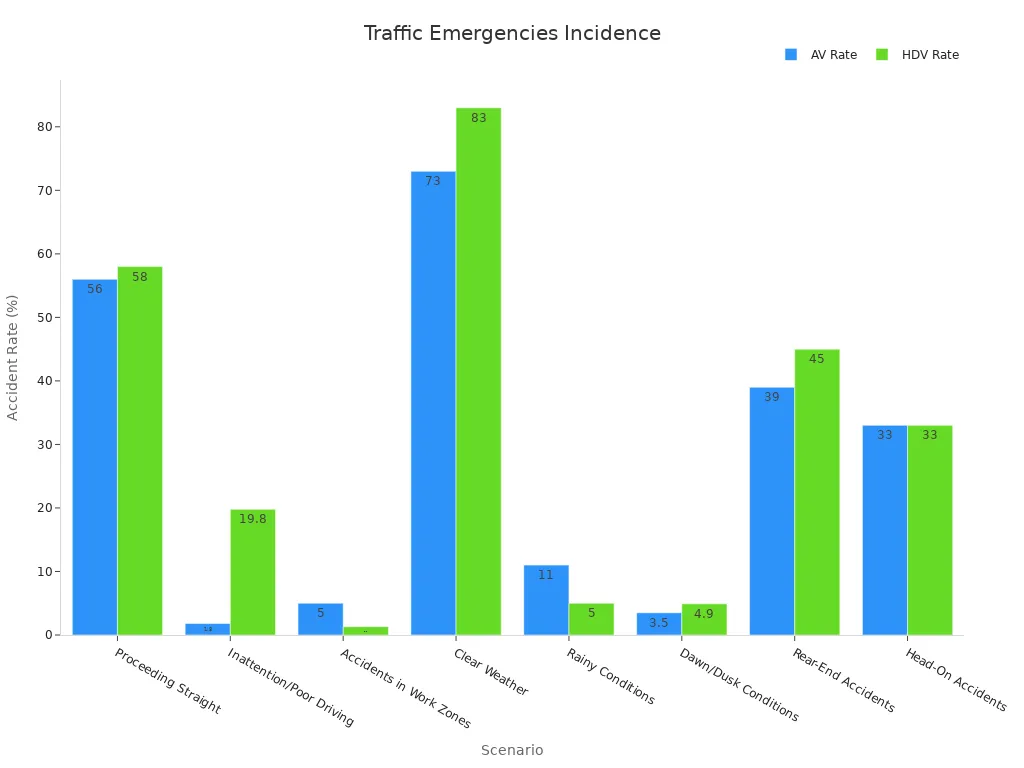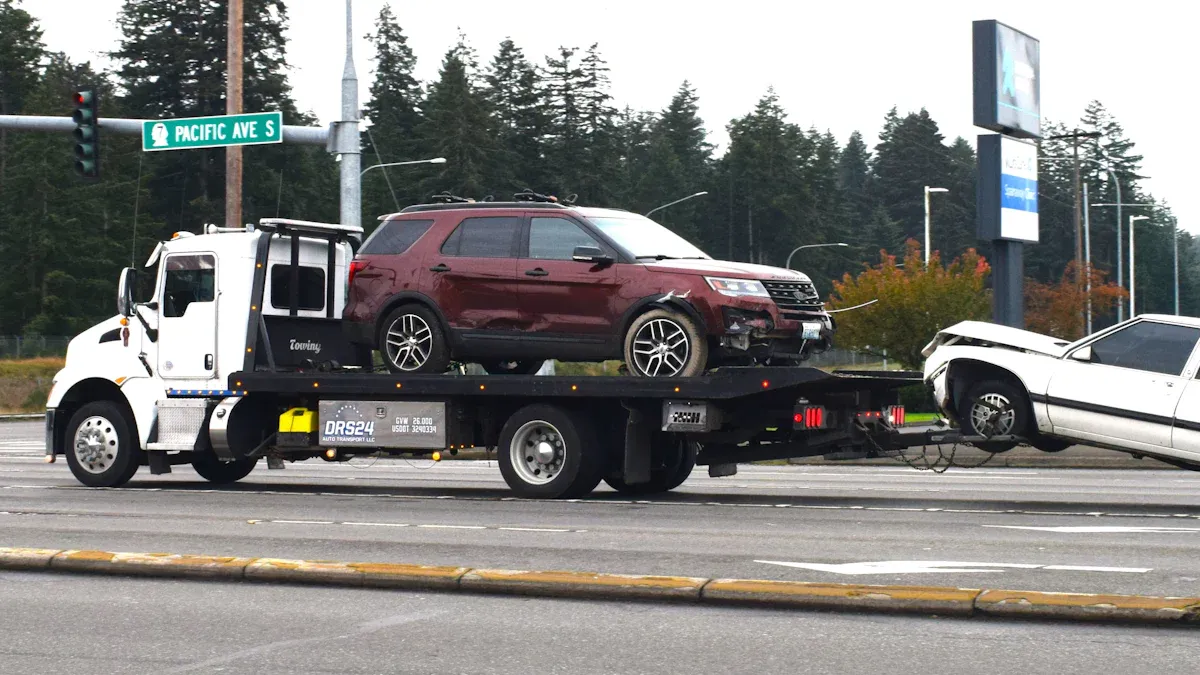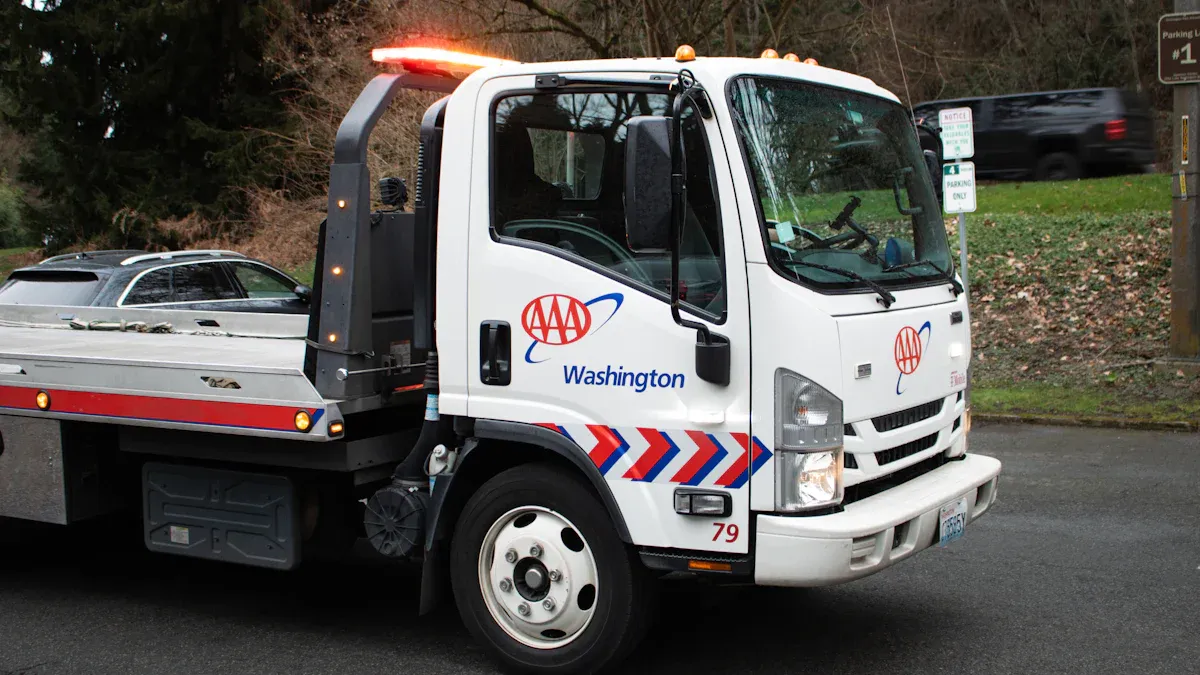
Roadside emergencies can occur unexpectedly, leaving drivers in challenging and unsafe situations. Each year, 27 million calls for emergency roadside assistance are made, with 13 million involving towing and 7 million related to battery problems. Having dependable roadside support ensures prompt assistance during these critical moments, providing peace of mind. From traffic emergency telephone services to towing solutions, these plans are designed to prioritize safety and convenience. Whether you require a rugged emergency telephone, un industrial heavy-duty telephone, o un waterproof outdoor telephone, there are specialized options available to address a variety of needs. Access to these essential tools can make a significant difference during high-stress situations.
Understanding Roadside Assistance
What Is Roadside Assistance?
Roadside assistance refers to a suite of services designed to help drivers during vehicle-related emergencies. These services address common issues such as mechanical breakdowns, flat tires, and lockouts. Providers offer support through specialized tools and trained professionals, ensuring drivers can resume their journeys safely and efficiently.
The industry defines roadside assistance through specific service categories, as shown below:
| Service Type | Description |
|---|---|
| Towing or flatbed transport | Up to 100 miles coverage for towing services. |
| Winching | Assistance for vehicles stuck in difficult situations. |
| Jump-starting a dead battery | Service to restart vehicles with battery issues. |
| Changing a flat tire | Help with replacing flat tires. |
| Key lock-out service | Assistance for locked keys inside vehicles. |
| Delivery of fluids | Provision of fuel, oil, water, or other necessary vehicle fluids. |
| Exclusions | Costs for supplies, replacement parts, and labor at service facilities are not covered. |
Why Is It Essential for Drivers?
Roadside assistance ensures safety and convenience during unexpected traffic emergencies. Drivers often face challenges such as being stranded in remote areas or dealing with hazardous weather conditions. Access to reliable support minimizes delays and reduces stress. For instance, a traffic emergency telephone can provide immediate communication with service providers, ensuring timely help.
Common Traffic Emergency Scenarios
Traffic emergencies occur under various conditions, often influenced by weather, driver behavior, or road environments. Recent studies highlight the most frequent scenarios:

The data reveals that rear-end and head-on collisions are among the most common incidents, with clear weather contributing to a majority of accidents. Drivers must remain vigilant and prepared for these situations, as they can happen unexpectedly.
Key Features of Roadside Assistance Plans

Towing and Recovery Services
Towing and recovery services play a vital role in managing traffic emergencies. These services ensure vehicles are promptly removed from accident sites, reducing congestion and preventing secondary accidents. Providers dispatch tow trucks equipped with advanced tools to clear wreckage efficiently. This intervention minimizes delays for commuters and freight carriers while restoring traffic flow. During natural disasters, towing services clear blocked roads, enabling rescue teams to reach affected areas faster. Statistics from the Federal Highway Administration reveal that nearly 25% of congestion stems from incidents, highlighting the importance of rapid towing responses.
Battery Jump-Starts and Replacement
Dead batteries often leave drivers stranded, especially in remote locations. Roadside assistance providers offer jump-start services to revive vehicles quickly. Professionals use specialized equipment to ensure safe and effective battery restoration. In cases where batteries are beyond repair, replacement services are available. These solutions provide peace of mind, particularly during extreme weather conditions when battery failures are more common.
Flat Tire Assistance
Flat tires can occur unexpectedly, disrupting travel plans and posing safety risks. Roadside assistance plans include tire-changing services, where trained personnel replace damaged tires with spares. This feature is especially valuable for drivers unfamiliar with tire replacement procedures. Immediate help reduces the time spent in hazardous conditions, ensuring drivers can resume their journeys safely.
Fuel Delivery and Refueling
Running out of fuel is a common issue, particularly during long trips or in areas with limited gas stations. Roadside assistance providers deliver fuel directly to stranded drivers, allowing them to continue their travels without delay. This service is available 24/7, ensuring help is accessible even during late hours.
Lockout and Locksmith Services
Lockouts can happen to anyone, leaving drivers unable to access their vehicles. Roadside assistance plans include locksmith services to unlock vehicles without causing damage. Professionals use modern tools and techniques to resolve lockouts efficiently. This feature is essential for maintaining safety and convenience during traffic emergencies.
Additional Perks and Benefits
Many roadside assistance plans offer extra benefits beyond basic services. These perks may include discounts on travel-related expenses, trip interruption coverage, and concierge services. Some providers also integrate modern technology, such as traffic emergency telephones, to enhance communication during critical situations. These additional features add value to the plans, making them more appealing to drivers seeking comprehensive support.
Top Providers for Traffic Emergency Telephone Support

Choosing the right roadside assistance provider can make a significant difference during traffic emergencies. Each company offers unique features and benefits tailored to drivers’ needs. Below is an in-depth look at the top providers for traffic emergency telephone support.
AAA (American Automobile Association)
AAA has long been a trusted name in roadside assistance, offering comprehensive coverage options. Members benefit from services such as towing, battery jump-starts, and lockout assistance. AAA also provides access to traffic emergency telephones, ensuring drivers can quickly connect with support during critical situations.
Despite its extensive offerings, AAA ranked 13th out of 22 providers in a WalletHub study. The evaluation considered coverage options, base plan features, cost, and Better Business Bureau ratings. AAA received an F grade due to unresolved customer complaints, highlighting areas for improvement in customer service. However, its widespread network and additional perks, such as travel discounts, continue to attract loyal members.
Allstate Motor Club
Allstate Motor Club stands out for its flexible membership plans and competitive pricing. Drivers can choose between basic and premium options, depending on their needs. The service includes towing, fuel delivery, and flat tire assistance, ensuring comprehensive support during emergencies.
Allstate’s mobile app enhances convenience by allowing users to request help directly from their smartphones. The app also provides real-time updates on service arrival times, reducing uncertainty during stressful situations. With a strong reputation for reliability, Allstate remains a popular choice among drivers seeking dependable roadside assistance.
Good Sam Roadside Assistance
Good Sam specializes in roadside assistance for RVs and larger vehicles, making it an ideal choice for travelers and outdoor enthusiasts. The service covers towing, tire changes, and battery jump-starts, with no restrictions on the size or weight of the vehicle.
Members appreciate Good Sam’s nationwide network, which includes over 40,000 service providers. This extensive coverage ensures help is available even in remote areas. Additionally, Good Sam offers discounts on camping gear and RV parks, adding value for those who frequently travel. Its focus on RV-specific needs sets it apart from other providers.
Better World Club
Better World Club is the eco-friendly alternative in the roadside assistance industry. The company emphasizes sustainability by offering carbon offsets and supporting environmental initiatives. Drivers can access standard services such as towing, lockout assistance, and fuel delivery, along with unique perks like bicycle roadside assistance.
While Better World Club may not have the same extensive network as AAA or Allstate, its commitment to green practices appeals to environmentally conscious drivers. The company also provides competitive pricing and personalized customer service, making it a strong contender for those seeking ethical roadside support.
USAA Roadside Assistance
USAA Roadside Assistance caters exclusively to military members and their families, offering tailored services to meet their needs. The plan includes towing, battery jump-starts, and flat tire assistance, ensuring comprehensive coverage during emergencies.
USAA’s reputation for exceptional customer service sets it apart from competitors. Members benefit from affordable pricing and access to a reliable network of service providers. The company’s focus on supporting military families makes it a trusted choice for those seeking specialized roadside assistance.
Comparing Costs and Value
Pricing Overview of Leading Providers
Roadside assistance plans vary significantly in cost and benefits, catering to diverse driver needs. For instance, Allstate Roadside’s standard plan costs $89 annually and includes two rescues, while Good Sam offers up to three rescues with pricing that depends on the specific plan. OnStar, a premium option, charges $359.88 annually, providing four rescues along with advanced in-car technology and concierge services.
| Plan Name | Annual Cost | Rescues Allowed | Additional Member Cost | Benefits |
|---|---|---|---|---|
| Allstate Roadside (Standard Plan) | $89 | 2 | $41 – $48 | Tire and wheel replacement, trip disruption compensation, free second member for AARP members |
| Good Sam | Varies | Up to 3 | N/A | Trip interruption compensation up to $1,200, discounts on hotels and rentals |
| OnStar | $359.88 | 4 | Additional fees apply | In-car technology, concierge services, emergency assistance, comprehensive car health reporting |
The growing complexity of vehicles and the rise of on-demand services have influenced pricing trends. Higher repair costs and deferred maintenance increase the likelihood of breakdowns, potentially raising the demand for roadside assistance services.
Basic vs. Premium Plans
Basic plans typically cover essential services like towing, battery jump-starts, and flat tire assistance. These plans are ideal for drivers seeking affordable solutions for occasional emergencies. Premium plans, on the other hand, offer enhanced benefits such as extended towing distances, concierge services, and advanced features like traffic emergency Telephone integration. For example, OnStar’s premium plan includes comprehensive car health reporting, making it a valuable choice for tech-savvy drivers.
Drivers must weigh their needs against the additional costs of premium plans. While basic plans suffice for short-distance commuters, premium options provide peace of mind for long-distance travelers or those with high-end vehicles.
Cost-Benefit Analysis for Different Needs
Selecting the right roadside assistance plan requires a careful cost-benefit analysis. For budget-conscious drivers, Allstate’s standard plan offers excellent value with essential services at a competitive price. Good Sam caters to RV owners and frequent travelers, providing unique benefits like trip interruption compensation and discounts on accommodations. OnStar, though more expensive, appeals to drivers who prioritize advanced technology and comprehensive support.
The expected market size for roadside assistance services is projected to reach $9.1 billion by 2030, driven by the increasing complexity of vehicles and the demand for tailored solutions. As the industry evolves, drivers must consider their specific requirements, travel habits, and vehicle types to choose a plan that balances cost and value effectively.
Choosing the Right Plan
Individual vs. Vehicle Coverage
Roadside assistance plans vary in their approach to coverage. Some plans focus on individuals, offering protection regardless of the vehicle they drive. Others provide coverage tied to specific vehicles, ensuring that the registered car receives assistance regardless of who operates it.
| Type of Plan | Description | Best For |
|---|---|---|
| Manufacturer Plans | Often included with new cars for the duration of the warranty, covering towing to authorized dealerships. | New-car owners |
| Insurance Company Plans | Can be added to insurance policies, covering all insured drivers and vehicles, often at a lower cost. | Families with multiple drivers and cars |
| Full-Service Plans | Offered by companies like AAA, providing extensive benefits and membership tiers. | Road warriors and drivers with older cars |
| Credit Card Plans | Basic coverage may be included, but often charge per incident. | Those without other coverage |
Drivers must evaluate their needs before selecting a plan. For families with multiple vehicles, insurance company plans offer cost-effective solutions. Road warriors or those with older cars may benefit from full-service plans that provide extensive coverage. Understanding these distinctions ensures drivers choose a plan tailored to their lifestyle.
Special Considerations for RVs and Motorcycles
RVs and motorcycles require specialized roadside assistance due to their unique needs. RV owners often face challenges such as towing large vehicles or accessing remote areas. Providers like Good Sam Roadside Assistance cater specifically to RVs, offering unlimited towing and discounts on RV parks.
Motorcycle riders encounter different risks, including flat tires and mechanical breakdowns. Plans designed for motorcycles include towing services that accommodate smaller vehicles and specialized repair assistance. Riders should prioritize providers with experience handling motorcycles to ensure reliable support during emergencies.
Choosing a plan for RVs or motorcycles requires careful consideration of the vehicle type, travel habits, and provider expertise. Drivers should seek plans that address these specific needs to avoid unexpected complications.
Checking Existing Coverage Options
Before purchasing a new roadside assistance plan, drivers should review their existing coverage. Many insurance policies, credit cards, and vehicle warranties include roadside assistance as an add-on or complementary service.
- Understanding current coverage helps avoid unexpected expenses.
- Not all roadside assistance policies are identical; knowing the specifics is crucial.
- Insurance companies often offer roadside assistance as a convenient and cost-effective add-on.
Drivers can save money by leveraging existing coverage instead of purchasing redundant plans. For example, manufacturer plans often cover towing to authorized dealerships during the warranty period. Reviewing these options ensures drivers make informed decisions and maximize their benefits.
Evaluating Customer Reviews and Ratings
Customer reviews and ratings provide valuable insights into the reliability and quality of roadside assistance providers. Analyzing feedback helps drivers identify strengths and weaknesses in service delivery.
| Proveedor | Pros | Cons |
|---|---|---|
| AAA | Comprehensive coverage, 24/7 availability, wide network | Membership required, limited to members |
| Allstate | Reliable service, high claims satisfaction, user-friendly app | Complex claims process, add-on costs |
| Geico | Cost-effective plans, wide availability, quick service | Limited coverage details, customer service concerns |
| Progressive | Variety of plans, flexible coverage, customizable policies | Variable service quality, higher costs for comprehensive plans |
| Nationwide | Dependable service, high-quality service, flexible plans | Complex add-ons, additional fees |
| State Farm | Excellent coverage, responsive customer service, discounts available | Service quality variation, higher premiums |
| Farmers | Customizable plans, customer-centric approach, discount opportunities | Service variability, complex policy adjustments |
| Liberty Mutual | Extensive coverage, good customer support, flexible options | Add-on costs, variable service quality |
| USAA | Tailored for military families, cost-effective, excellent service | Eligibility restrictions, potential for overlap |
| Travelers | Strong customer support, customizable options, high coverage limits | Potential delays, higher premiums |
Drivers should prioritize providers with high customer satisfaction ratings and dependable service networks. For example, AAA offers comprehensive coverage and a wide network but requires membership. USAA excels in serving military families with tailored plans. Evaluating reviews ensures drivers select providers that align with their expectations and needs.
Choosing the right roadside assistance plan ensures drivers receive reliable support during emergencies. Top providers like AAA, Allstate, and Good Sam offer unique features tailored to diverse needs.
- The average cost of roadside repair reached $491 in early 2020, a 30% increase from the previous year.
- Additional expenses, such as towing and delays, highlight the value of dedicated assistance.
Drivers should evaluate their travel habits and vehicle requirements to select a plan that provides peace of mind and minimizes unexpected costs.
FAQ
What should drivers consider when choosing a roadside assistance plan?
Drivers should evaluate their travel habits, vehicle type, and budget. Comparing coverage options and customer reviews ensures the plan meets their specific needs.
Are roadside assistance plans worth the cost?
Yes, they provide peace of mind and reduce unexpected expenses during emergencies. Services like towing, fuel delivery, and lockout assistance often outweigh the annual membership fees.
Can roadside assistance plans cover multiple vehicles?
Some plans offer individual coverage, while others cover specific vehicles. Drivers with multiple cars should consider insurance-based plans or memberships that include family or multi-vehicle options.


